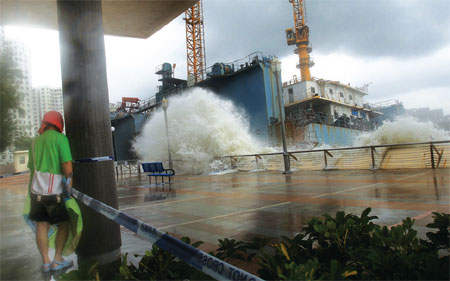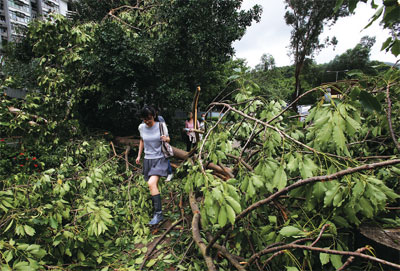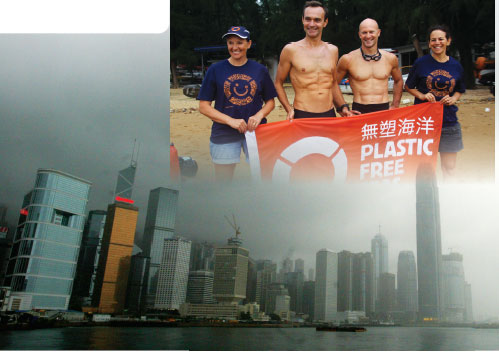Facing the gathering storm
Updated: 2015-03-24 07:58
By Wang Yuke.(HK Edition)
|
|||||||
As HK Observatory anticipates more storm surges in the future,
a new technology developed by Chinese University of HK engineers might help raise alerts 72 hours in advance. A report by Wang Yuke.
Hong Kong is gearing up to mobilize advanced technology to confront dangers posed by climate change, super typhoons and the threat of devastating storm surges that come in the wake.
The Marine Environment Prediction System, developed by the Chinese University of Hong Kong (CUHK), observes nuances of tidal conditions, affording a 72-hour early warning of dangerous storm surges. The developers say that's much earlier than present technology allows. The new technology may soon become part of the forecasting array at Hong Kong Observatory.
Melting polar ice, rising seas and the imminent risk of floods threaten coastal cities all around the world. Hong Kong has consolidated its infrastructures to counter the threat of floods borne on incoming waves. The Civil Engineering and Development Department will repair the wave wall at Tseung Kwan O's South Waterfront Promenade, toppled by Typhoon Kalmaegi last September. The bike lane and footpath were reduced to rubble. "That is not enough," said Sai Kung District Councilor Christine Fong Kwok-shan, who is a building engineer, "we need a forecast system that can inform us of big waves and imminent floods."
"The two countermeasures (coastal infrastructure and a forecasting system) are complementary when it comes to tackling typhoons and we can't afford to miss either one. Hong Kong repairs its dams but has given little attention to software capabilities to warn of incoming events," Fong added.
The CUHK's Marine Environment Protection System is still in trials, awaiting approval by the Innovation and Technology Fund before being embraced by the Hong Kong Observatory. The system already has passed important tests, by accurately predicting wave height prior to Typhoon Kalmaegi.
Pan Jiayi, who leads the development team, and Lin Hui, director of the Institute of Space and Earth Information Science at CUHK, told China Daily, "that day brought the highest astronomical tide of the year: the strongest gravitational effects of the sun and moon combined. We predicted that when the typhoon swept across Hong Kong, the wind would push the waves higher to a meter above normal sea level." The prediction proved consistent with the actual measurement taken by the Hong Kong Observatory.
"Our job is just to provide information to the government and other organizations. It's the Observatory's duty to act on the information," said Pan.
Rising like never before
The need for a comprehensive marine forecast system comes in the face of climate change and expectations that typhoons and super typhoons will become more numerous and more intense in the middle and late 21st century, said Alexis Lau, professor in environmental engineering at Hong Kong University of Science and Technology.
The rise of sea levels is becoming more rapid and more noticeable. It's a global trend affecting Hong Kong. The Hong Kong Observatory began measuring tidal action in Victoria Harbour in 1954 with mean sea levels gauged annually. During the more than 60 years since, the increase of sea level evolved much more rapidly over the past 30 years than in the previous 30. According to the Fifth Assessment Report of the Intergovernmental Panel on Climate Change (a Geneva-based international body for assessment of climate change), the mean sea level rise is projected to reach 0.38 m by the mid-21st century (2046-2065) and 0.82 m late in the 21st Century (2081-2100).
"It is a chronic progression that won't have an immense impact in the short term," Pan said. But it indicates an acceleration of the rising sea level in Victoria Harbour during the remainder of the 21st Century.
"A number of factors can trigger extreme sea level rise," said Lau, explaining how the Marine Environment Protection System operates. "Extreme sea level rise can stem from tropical cyclones around Hong Kong," he reasons.
Indeed, Hong Kong Observatory anticipates more storm surges in the future. 2014 was the hottest year on record since 1884 and Hong Kong will get even warmer in future, the Observatory warns. Hong Kong's coastal areas are likely to be exposed to more storm surges.
Shun Chi-ming, the Observatory's director, disclosed on Monday that the mean sea level rise in Hong Kong and adjacent waters would top at 1.07 m by the end of the 21st century, prompted by severely high greenhouse gas concentration.
The fate of Hong Kong is linked closely to that of the whole world. A research, published in the monthly journal Nature Geoscience in March, reveals that a glacier in Antarctica is now melting rapidly due to climate change. It could trigger a 10-feet (about 3-meter) rise in sea levels around the world.
The study's co-author Martin Siegert from Imperial College London said in the paper that the 3.5-meter rise may take several centuries to complete, but the process has started and it's likely irreversible.
"Although there are still no conclusive findings, many scientists believe global warming is a major contributing factor to the spawning of typhoons," Pan added.
Winds generated by typhoons are immensely powerful and capable of producing the dangerously high waves that lead to storm surges. When the storm surge coincides with a high astronomical tide, "the sea level can jump to 3 or 4 meters or even higher," Lau warned.
Lau believes CUHK's forecast system is viable and will assist efforts to save lives and reduce property damage.
"When a typhoon-induced storm surge pushes sea water inland, it's quite dangerous for ships' crews and longshoremen loading and unloading ships. With the predictive system, workers receive earlier warning to evacuate," he continued, "Even when a vessel is out at sea, the system can forecast important marine changes up to 72 hours in advance. We can give a ship's captain advance warning to assist him in making a professional judgment."
Falling behind
Nic Robinson is a British science consultant, who runs Pleasure Craft Services in Hong Kong. He asked Pan to gauge the potential risk to marathon swimmers of Lantau Island last November.
"Two guys were about to swim 75 km over five days for a charity fund-raising event.
"The forecast alerted us that when the two guys swam to the Ma Wan Channel, they would encounter rough waves that would make their advance challenging," Robinson recalled. The prediction system allowed the swimmers to make better preparations, he said.
Pan said the CUHK system also assisted with clearing a spill of plastic pellets from a ship during Typhoon Vicente in 2012, and aided in the rescue of passengers after two vessels collided near Lamma Island in early October 2012. He said the system also provided ocean data in the investigation that followed the deadly collision.
Neither the Marine Department nor the Observatory would comment on the CUHK claims. Pan did however forward an email from a senior surveyor of the Marine Department surnamed Li asking the CUHK team for assistance into the investigation of the Lamma Island ferry disaster. The request specifically asked for information on ocean currents.
Pan admits to being frustrated by the government's cool reception to the new technology. Nevertheless, he and Lin Hui are confident their system will pass the Innovation and Technology Fund's testing, on the basis of the forecast accuracy being around 80 percent.
Contact the writer at jenny@chinadailyhk.com
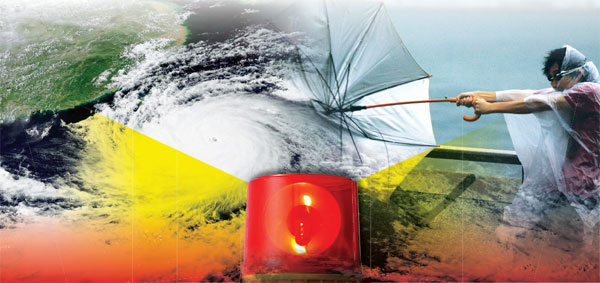
|
A cargo barge crashed into the sea wall in Heng Fa Chuen during the Typhoon Nesat in September 2011. Edmond Tang / China Daily |
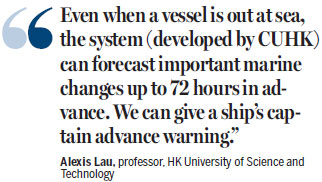
|
Super Typhoon Kalmaegi wreaked havoc in Tai Po in 2014. Edmond Tang / China Daily |
|
Bruce Pye and Olivier Baillet (men in middle) smoothly completed the swim around Lantau Island, thanks to the technology developed by CUHK scientists, alerting them about impending rough weather. Provided to China Daily |
(HK Edition 03/24/2015 page7)
